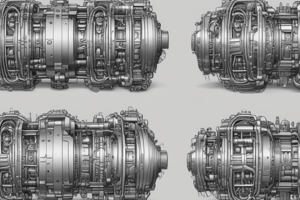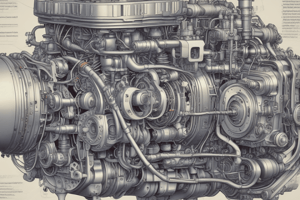Podcast
Questions and Answers
¿En qué tipo de aplicaciones es común encontrar motores de dos tiempos?
¿En qué tipo de aplicaciones es común encontrar motores de dos tiempos?
- Motocicletas y motos de agua (correct)
- Cocina industrial
- Aviones comerciales
- Automóviles de alta gama
¿Cuál es la función principal de la carrera de admisión en el ciclo de un motor de dos tiempos?
¿Cuál es la función principal de la carrera de admisión en el ciclo de un motor de dos tiempos?
- Introducir la mezcla de aire y combustible al cilindro (correct)
- Expulsar los gases quemados
- Generar la chispa para la ignición
- Comprimir la mezcla de aire y combustible
¿En cuántas carreras se divide el ciclo de trabajo de un motor de dos tiempos?
¿En cuántas carreras se divide el ciclo de trabajo de un motor de dos tiempos?
- Ocho
- Cuatro (correct)
- Seis
- Dos
¿Qué sucede durante la carrera de compresión en un motor de dos tiempos?
¿Qué sucede durante la carrera de compresión en un motor de dos tiempos?
¿Cuál es el producto final de la carrera de combustión en un motor de dos tiempos?
¿Cuál es el producto final de la carrera de combustión en un motor de dos tiempos?
¿Qué tipo de máquinas pueden utilizar motores de dos tiempos según el texto?
¿Qué tipo de máquinas pueden utilizar motores de dos tiempos según el texto?
Flashcards are hidden until you start studying
Study Notes
Two-stroke engines have been used in various applications due to their efficiency and simplicity. These engines work based on the four-cycle operation that completes two combustion cycles per revolution of the crankshaft. Here's more information about two-stroke engines:
Common Applications
Two-stroke engines are commonly found in motorscooters, motorcycles, go karts, chainsaws, outboard marine engines, jet skis, small lawn mowers, weed eaters, leaf blowers, log splitters, power tillers, generators, water pumps, portable electric drills, and other similar machines. They are also used in airplanes such as helicopters and gliders.
Operating Principle
The working cycle of a two-stroke engine is divided into four strokes: intake stroke, compression stroke, combustion stroke, and exhaust stroke, all occurring within one complete turn of the crankshaft.
Intake Stroke
The engine starts with its piston moving downward, which pulls the mixture of fuel and air through the carburetor, creating suction. This intake process fills the cylinder with the fresh charge of fuel and air needed for the next step.
Compression Stroke
As the piston moves upward in compression, it compresses this fuel-air mixture, making it ready for ignition.
Combustion Stroke
When the spark plug fires during this phase, the compressed mixture inside the cylinder explodes from the heat released by the spark, pushing the piston back down. This force turns the crankshaft via a connecting rod, generating torque that propels the vehicle forward.
Exhaust Stroke
Finally, the exhaust valve opens up, releasing the burned gases left over from the combustion stroke, and the piston's return movement expels these gases out of the system. This allows the engine to begin the intake stroke again, starting the cycle once more.
Studying That Suits You
Use AI to generate personalized quizzes and flashcards to suit your learning preferences.




